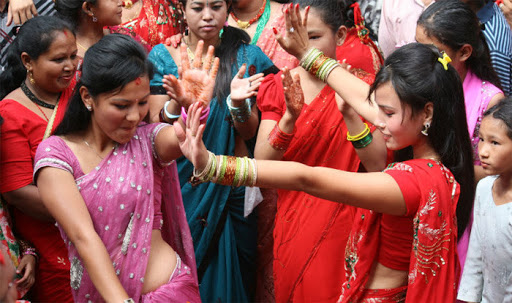Teej Festival : Background
Nepa is a multi-ethnic, multi-cultural and multi-religious nation. People of various cultures and ethnicity reside inside Nepal. Feasts, festivals, and social celebrations are the most important cultural assets of Nepal. Because of religious and social diversities in Nepal, various festivals and celebrations are enjoyed in Nepal with great joy and jubilation. Dashain, Tihar, Chhath, Teej, Lhosar, etc. are some important festivals of Nepalese society.
Among these festivals, Teej is one of the biggest festivals of Hindus and purely a Women’s festival celebrated in Nepal and North India. It is the festival that women celebrate for their prosperous marital life and long life of the husband. According to the Nepali calendar, the Teej festival is generally celebrated on the third day of Bhadra Shukla Paksha which generally falls in early September or late August. It is three days long festival celebrated to welcome the Monsoon season. Teej is the monsoon festival celebrated in the western and Northern and Western states of India and Nepal.
The literal meaning of the word ‘Teej’ is a kind of insect, red in color that comes out of the soil during the rainy season. It is believed that the name of the festival came from the same insect and that’s why the Teej festival is the celebration with the color red. It is the festival that is dedicated to the nature of Gods and Goddess Lord Shiva and Parvati. Moreover, the Teej festival remarks on the celebration for nature, greeneries, rain and much more. This festival commonly involves eating a delicious feast, taking fasting for the day, singing, dancing and much more.
First Day
The first day of Teej is often referred to as “Dar Khane Din”. On this day, both married and unmarried women gather at one place on their finest dresses and jewelry (Swara singhar). The grand feast takes place in the evening time. Women enjoy delicious food items called “dar”. The term “dar” is often referred to as heavy or more foods that women are supposed to have the day before of the fasting. Moreover, the celebration also involves dancing and singing on Nepali folk and devotional songs. It is the day when women have full freedom of expression and they enjoy forgetting all their sorrows and problems.
The Second Day
The second day is the most important day of the festival, called the fasting day. On this day, women take fasting until midnight. Both married and unmarried women observe the fasting on the day. Some women take rigid fasting without even taking fruits and a single drop of water whereas some of them take the fruits or water.
On the day, women present themselves in red saris with other beautiful pieces of jewelry and visit the nearby temple of Lord Shiva and enjoy by singing, dancing with others. They offer fruits, flowers to Lord Shiva and Parbati in the temple for their blessings. Married women observe the fast for the prosperity, long life of their husband and progress of family whereas unmarried women take the fast for getting blessed with a good husband. Another important part of this day is the burning of the oil lamp throughout the night by which it is believed to bring happiness in the family.
Third Day
On the third day morning, women get up early, take the bath and perform the puja to Diyo with banana and holy basil. After the completion of pooja, they break their fast taking solid food. This day is also known as Ganesh Chaturthi. Rishi Panchami The Panchami is mainly devoted to cleaning the body with red mud on sacred Datiwan bush, along with its leaves, in the rivers for any sin or impurity the women folks may have committed during the previous year.
On this day, women worship the seven Rishis in reminiscence of the high ascetic tradition of Hinduism and a notion of purity of descent in their lineage from the ancestral Rishis. Teej is the greatest festival of joy for every woman. Women of every part of Nepal celebrate this festival taking the fast, enjoying by dancing singing and much more. Moreover, married women are invited to the home by their parents for the meal(dar). Women are seen in red saris and valuable ornaments both inside and outside of the valley. Hence, the Teej festival is regarded as the festival of women that brings joy and strengthens the bond between women, husband as well as her family.
Thanks You!!








No comments:
Post a Comment
Thanks you!!